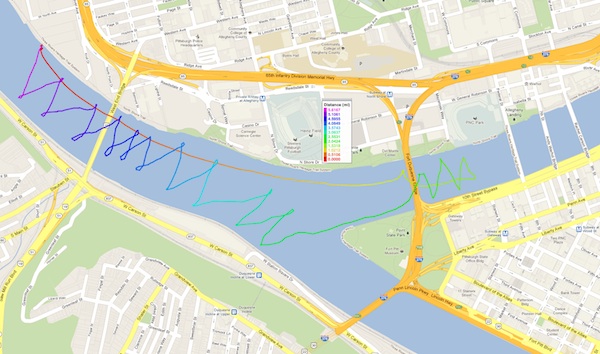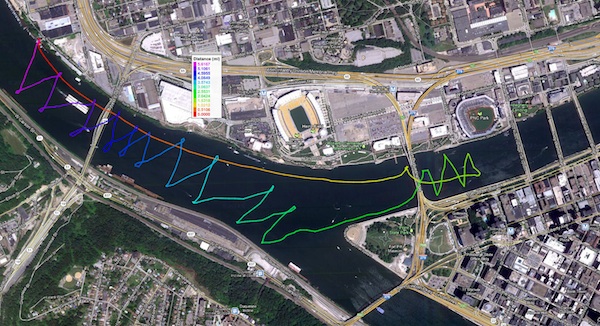Windy Day
June 26, 2012
It had taken me a little longer than usual to start this, my fourth summer season of sailing on the rivers around Pittsburgh's Point. The difficulty is that there are so many other things to do. My Center ran a reunion conference for around 50 speakers in Southwestern Turkey in early June. That took some of my attention. Eve and I did get to spend a few days ahead of the conference in the quite amazing city of Istanbul.
We took the obligatory ferry ride on the Bosphorus. This is a waterway that separates Europe from Asia. It is a major conduit of shipping between the Black Sea and the Sea of Marmara, which in turn connects to the Mediterranean. This waterway has been a locus of strife as far back as anyone can remember. Homer recorded Greek efforts to control it. He recounted in the Iliad how their fleets set out on some pretext to go after the Trojans, whose city controlled the Southern entrance to the Bosphorus.
As we gazed from the ferry over the busy water, I kept wondering what it would be like to sail there. We saw only one or two sailboats.
They were not under sail. Reading later, I found what I suspected. The Bosphorus connects two seas and is relatively shallow, so there can be a considerable current of perhaps 3-6 knots, sometimes even running opposite to the prevailing flow. Also it is quite choppy, which gave the water a liveliness that isn't captured in still photos. I didn't see many smaller boats out. One I did see was obviously fighting the chop and who knows what else. These are not waters friendly to little boats.
It was portent of things to come.
Over this past weekend, I retrieved my little Hobie Bravo from the sheltered spot in which it had spent the winter.
With a little help, I hauled it up onto its launch ramp and cleaned off the grime that the winter had left. All that was needed now was a good day to sail when I was free to get down to the river.
That day came today. The river currents have been low enough for a while to sustain sailing. Here's the flow on the Ohio
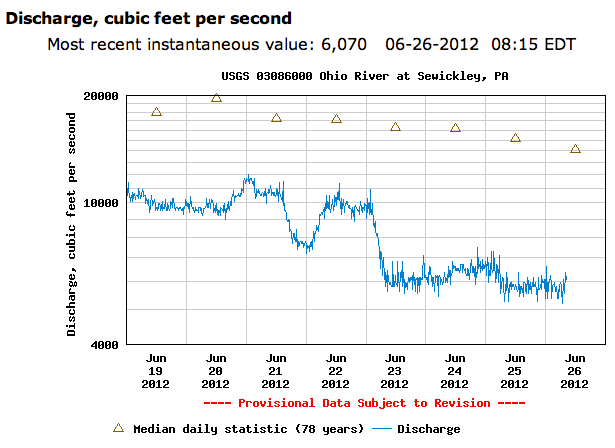
A few days ago, it dipped down from a quite manageable 10,000 cubic feet per second to a mere 6,000. That, I knew from past years, meant that there would be no discernible motion on the river. (Here's the Allegheny and the Mon.) The temperatures were pleasant. They were in the high 60s rising to low 70s, with just a little cloud now and then. Quite perfect.
What was not quite so perfect was the wind. There was just too much of it. The forecast had it building through the day to 15-16 mph with gusts in the low 20's.
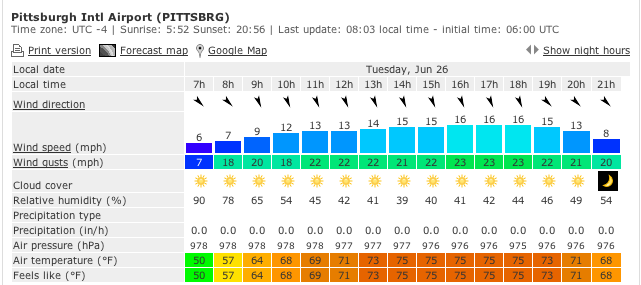
Since the winds were lower in the morning, I planned an earlier start. However, when I cycled over to the marina, I saw lots of whitecaps on the river. That is a bad sign. They form at about 15 mph. The winds were already blowing hard and thus likely to blow even harder as the day progressed. I met Linda and Mort at the marina. They'd come to clean off their kayak. We all looked out over the water, watched the little flags flutter energetically and wondered if today was a good day to be out there.
When I had decided that it was best leave sailing for another day, I looked out over the water one last time. A calm had descended. Then the internal debates started. Be sensible. It won't last. Live to fight another day... But I'd made all the effort of getting myself to the water at the right time. How bad could it be? I can sail. I can deal with wind. Don't be so timid. You have to try... I can usually censor these voices. They so often lead to trouble. This time, my censor was weak. Soon the mast was up and, at 10:45, I was moored at the end of the dock ready to go.
Once the sail was unfurled, the sailboat took off into the water, like a horse who knew the route and could not be slowed. Since there was so much wind, I reefed the sail--that is, I rolled up some of it round the mast to reduce its area. That is easy to do with a Hobie Bravo. You just pull a little blue string and the sail starts to wind up like a roller blind.
Here I am heading towards the West End Bridge and downtown. You can see the reefed sail.
I took another shot "blind" into the air hoping to catch the sail:
This part of my little voyage was the easy part. The wind was at my back and the sail is little more than a big bag catching the wind, blowing me onward. I am on a "run," to use sailors' talk. Even with the reefed sail, I made a steady 4-5 mph, according to the gps receiver hanging round my neck. I didn't doubt it. Looking back, I could see a quite creditable wake rising behind me, a direct indicator of speed.
In 15 minutes, I had passed the submarine at the Science Center and reached the Point.
Looking over to my port, I could see that they were still working on the fountain. It has not been working for the past four years of my sailing. I'm eagerly waiting for it to be reinstated. What better way to see how the wind is blowing than to watch what the wind does to that water spout! As it was, I managed pretty well by keeping an eye on the few flags visible on shore, such at the flag on Heinz Field.
I turned my bows up the Allegheny. Its shore was packed with moored boats, a common sight of the summer.
The winds are blowing from the Northwest, so they blow straight down the Ohio to the Point. The Allegheny is aligned Northeast-Southwest, so these wind strike it side on. What I expected happened. The buildings along the Northern shore of the Allegheny blocked the winds. When I arrived at the Fort Duqesne Bridge, things stalled.
I'd hoped I could still sail on a little way. There was wind, even if a little deflected and erratic. I managed to sail as far as PNC Park before I decided it wasn't worth fighting the erratic wind to go farther.
At 11am, I turned back, unreefing the sail, since would now be tacking into the wind and would want all the sail area I could have.
The sail home was more difficult that I expected. Once I'd passed the Fort Duquesne Bridge, I found steady winds on my side ("beam"), so I managed a fast beam reach to the Point. There the winds strengthened further. They were blowing unobstructed from the Northwest straight up the Ohio. I knew that there was just too much wind for my little boat. So I reefed the sail again. I'd been "flying a hull"--that is, heeling over so far that one of my two hulls is out of the water. That is not a good thing to do with the blustery erratic winds here. I need to hike out--lean back over the water to keep balance. When the gusty wind surges and ebbs, one way or another, I'm likely to tip.

It was a long, difficult sail back to the Newport marina, a little over a mile downstream of the Point. I had to tack directly into the wind. I didn't want to stop to measure the wind speed. I'd lose too much ground if I heaved to. The wind would blow an idle sailboat back upstream. Taking measurements at the dock later, I estimated that the wind had already risen to 15-25 mph. The water was covered with whitecaps. Worse, the winds were whipping up a steady chop. Small waves of height 1/2-1 foot were being blown along by the wind. I had to sail right into them. Waves that height don't sound like much. But they are a real obstacle to a sailboat whose deck is only inches above the water. As the wave passes, the bow rises, pivoting as if there's a 6 inch log under it. Then the bow falls into the valley after the crest has passed. All this bleeds off any speed I might have gained.
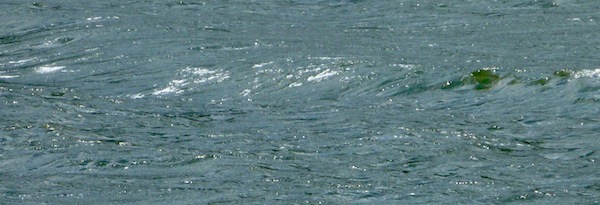
It may seem that I would sail fast in winds this strong. The reefing of the sail, the need to sail close hauled to the wind and the steady pounding of the waves meant things were otherwise. The gps tracks of the sail tell the story pretty well.
The return leg of the voyage is the drawn out, zigzagging on the left as I make my way up to the Northwest corner of the map. The zigzags are closely packed, since I am not making much headway with each tack. The Hobie Bravo sails well, but it does not tack well. At the best of times, it is hard to make the 90 degree turns across the wind that constitute much of tacking into the wind. When the wind is strong and the sail is reefed, it can be virtually impossible. Then I must make the 270 degree turns called "jibing." Instead of the bows nosing through the wind, the stern passes the wind. It is not an elegant or well-controlled maneuver. They are the little loops visible at the corners of the zigzags. The speed coded track shows just how hard I was working. Even with winds this strong, I managed only to make 2-4 mph most of the time over the water.
At 12:30, my last tack took me straight into the little lagoon at the Newport marina, where I moor my boat. This was a shorter sail than normal, but I was happy to bring it to a close. It had been hard work. Sandy, the marina owner, saw me struggle to slide the boat up its ramp and came out to lend a hand.
John D. Norton
Back to main
